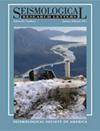中国和美国两个大型地震阵列对多个微地震 P 波源区的可分辨性
IF 3.2
3区 地球科学
Q2 GEOCHEMISTRY & GEOPHYSICS
引用次数: 0
摘要
P 波微地震有助于了解海洋波。利用地震数据解析和定位多个 P 波源区可提供有关海浪的宝贵信息。多个微地震 P 波源区的可分辨性取决于定位精度和分辨率,而使用多个大型地震阵列可以提高定位精度和分辨率。在本文中,我们结合位于中国(ChinArray)和美国(USArray)的两个大型密集地震台阵的反投影结果,研究了周期为 5-10 秒的 P 波微地震的震源位置。我们独立处理了 ChinArray 和 USArray 在北太平洋和北大西洋边界两年(2014-2015 年)内记录的数据。然后对结果进行归一化处理,并在震源区域求和或相交,通过减少与速度结构模型和阵列响应函数的偏差来提高 P 波微地震震源位置的准确性。结果表明,我们可以在一个大型 P 波源区内分辨出两到三个尺度为 500-1000 公里的源。我们还研究了阵列参数(如孔径、站间距和地理位置)如何影响 P 波微震源的可探测性和精度。反投影观测和海洋模式预测的 P 波微地震源位置在震源数量、震源规模和震源区域范围方面存在差异,这意味着海洋模式需要改进。本文章由计算机程序翻译,如有差异,请以英文原文为准。
Resolvability of Multiple Microseismic P-Wave Source Regions with Two Large Seismic Arrays in China and the United States
P-wave microseisms are useful for understanding ocean waves. Resolving and locating multiple P-wave source regions using seismic data can provide valuable information about ocean waves. The resolvability of multiple microseismic P-wave source regions depends on the location accuracy and resolution, which can be improved using multiple large seismic arrays. In this article, we investigate the source locations of P-wave microseisms at the period of 5–10 s by combining the backprojection results from two large dense seismic arrays located in China (ChinArray) and the United States (USArray). We independently process data recorded by ChinArray and USArray during a two-year period (2014–2015) that border both the North Pacific and North Atlantic. Then the results are normalized and summed or intersected in the source region to improve the accuracy of the P-wave microseism source locations by reducing the deviation from the velocity structure model and the array response function. The results show that we can resolve two to three sources with a scale of ∼500–1000 km within one large P-wave source region. We also investigate how array parameters such as aperture, interstation spacing, and geographic position affect the detectability and accuracy of the P-wave microseism sources. The discrepancy in P-wave microseism source locations between backprojection observation and ocean model predictions in source number, source scale, and source region scope imply that the ocean model needs to be improved.
求助全文
通过发布文献求助,成功后即可免费获取论文全文。
去求助
来源期刊

Seismological Research Letters
地学-地球化学与地球物理
CiteScore
6.60
自引率
12.10%
发文量
239
审稿时长
3 months
期刊介绍:
Information not localized
 求助内容:
求助内容: 应助结果提醒方式:
应助结果提醒方式:


